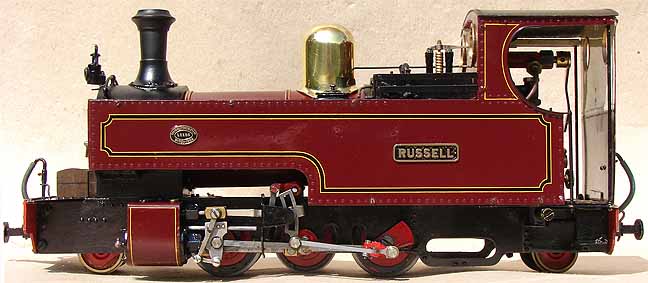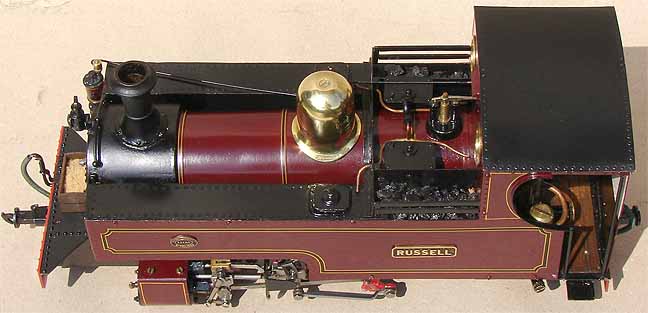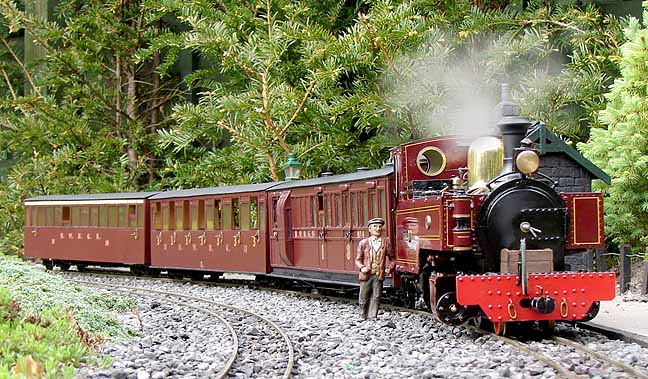Back to Sidestreet Bannerworks
Click here to find out how your engine can be featured!
.


Paul Millington's Russell
by Keith Skillicorn
Southport, England
Photos by the author
October, 2012
The full-size engine was built by the Hunslet Engine Company in 1906 to a design broadly similar to those built for the 2' 6”-gauge railways in Sierra Leone. There were some notable differences however. For instance, apart from the gauge, there were no cutouts in the frames to allow the pony trucks to swing, as the loco could negotiate curves down to three-chain radius without this facility. In truth, the loco was more akin to leeds No. 1 as supplied to the Masham Brewery Railway
Russell was originally ordered by the Portmadoc, Beddgelert & South Snowdon Railway for use on their proposed line to connect the Croesor Tramway at Croesor Junction to the North Wales Narrow Gauge Railways terminus at Rhyd Ddu. The loco was actually delivered to the North Wales Narrow Gauge Railways, as the PBSSR Company didn't have a railway to actually run it on.
The engine was put into service in between Dinas & Rhyd Ddu. The PBSSR didn't ever actually connect the two railways but did much in the way of earthworks, notably in the pass of the Aberglaslyn. Completion was left to the Welsh Highland Railway, which they finally managed to do in 1923.
The model
This loco was built in 1995 by Paul Millington, who supplemented his income as an engineering student by building 16mm scale, live-steam locomotives. The loco has a wealth of details, including full rivets on the side tanks and correct smoke box and chimney.
The wheelbase is correct to prototype, requiring the use of some bespoke parts as well as standard Roundhouse valve-gear components. Cylinders are standard Roundhouse items. The loco is gas fired, with the gas tank located in the left-hand side tank. A water top-up valve is under the dome and there's a gauge glass in the cab.
Other cab controls include steam regulator, reversing lever, gas valve, and a blowdown for the water gauge. The loco was painted by Paul but the lining was contracted out to Geoff Munday, who had recently started his Lightline lining service. The model was delivered to me in this condition and I must say that I was very pleased with it indeed.
Many years have now passed since Paul built Russell for me and I'm glad to say that we have kept in touch. When the engine began to show signs of wear a couple of years ago, Paul took it back and replaced the axle bushes and a couple of brass bearings on the connecting rods. The engine came back nice and tight, as if it where new again. A little running in saw the performance back to normal.
The run
The loco was oiled round in the usual way and the water level in the boiler was topped up. Filling the gas tank, which is fairly large, was next on the list. I opened the gas valve and lit the burner which ignites with a “pop”. It took about six minutes for the loco to raise steam to blow-off pressure.
I placed the loco on the track for a warm up. The condensate clears very quickly on this engine and I ran it in both directions for about 20 feet.
The train, consisting of three NWNGR four-wheeled coal wagons, four bogie coaches, and a four-wheeled van, was coupled up and off she went: no drama, just a nice chuff only slightly marred by the relatively noisy gas burner. With the water topped up to the top of the gauge glass the loco will run out of gas well before the boiler is empty. A run of between 35 & 40 minutes can usually be achieved on one fill of the tank, depending on the load, weather, and ambient temperature.
Conclusion
Russell has been a prime mover on my railway for many years and I have no doubt it will go on that way for many more.
Here's a video of Russell with a heavy train of 11 coaches. If, for some reason, you can't see it, click here.
|
|
|
| Builder | Paul Millington (UK) |
| Date completed | 1995 |
| Gauge | 0 (32mm) |
| Scale | 16mm = 1'0" |
| Boiler type | Center flue |
| Fittings | Steam Regulator, Safety Valve, water gauge, top up valve |
| Fuel | Butane |
| Cylinders | Two, double-acting D-valve |
| Reversing gear | Simplified Walschaerts |
| Lubricator | Displacement |
| Blowoff pressure | 60 psi |
| Dimensions | Length over buffers, 350mm; height to top of chimney, 147mm; overall width, 98mm |
| Weight | 8 pounds |








.jpg)
Back to Sidestreet Bannerworks
Click here to find out how your engine can be featured!
This page and its contents
Copyright Sidestreet Bannerworks, 2012